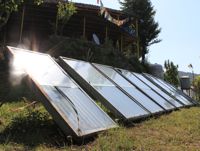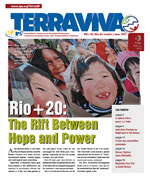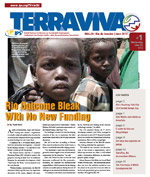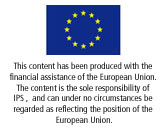By Marwaan Macan-Markar
KATHMANDU, May 30, 2012 (IPS) – After years of working out of a small, dimly-lit office in a crowded bazaar here, Yug Tamrakar has just moved up a gravel road to occupy five floors of a new building, where sunlight pours through large glass windows.
The light in the new premises of the 52-year-old’s company is a glistening reminder of how this Nepali entrepreneur made his fortune: supplying solar power in this Himalayan nation.
“We had to move because our business is expanding,” says the managing director of the Kathmandu- based Solar Electricity Company, a pioneer in the field of clean energy in South Asia’s poorest country. “We have already installed solar systems in 100,000 homes, many of them in communities spread across the mountains and the middle hills.”
That such a windfall is far from over is echoed in the calls he receives on his mobile phone while seated for this interview in his office. The calls were for three orders of solar photovoltaic (PV) electricity systems, which, at a basic level, come with a solar panel on the roof of a house, a battery, an electronic controller and solar tube lights.
“The demand is being driven by rural communities who have family members sending money home from jobs as migrant workers in foreign countries,” Tamrakar says. “They want electricity for light at night to charge their mobile phones and to watch TV.”
Similar stories of a growing boom in Nepal’s solar sector arise across this capital city, which has seen the number of solar companies rise from 10 in 2001 to close to 80 by 2012. These accounts are timely in the run-up to the June U.N. summit in Rio de Janeiro, also called Rio+20.
Promoting a green economy is one of the main environment-friendly themes to be addressed when thousands of government leaders, policymakers and activists gather at the Brazilian city to mark the 20th anniversary of the 1992 Earth Summit in Rio.
Asia-based U.N. agencies and financial institutions have been drumming home this message since early this year. “The market for green goods and services is vast and growing and with the right policies and investments, Asia and the Pacific could lead the world towards a more sustainable future,” Nessim Ahmad, director of the environment division at the Manila-based Asian Development Bank, said at the February launch of a report, ‘Green Growth, Resources and Resilience – Environmental Sustainability in Asia and the Pacific’.
Such potential is amplified in the areas Rakesh Shrestha, another solar-power pioneer and marketing manager of Lotus Energy, has tapped in this landlocked country. Besides homes, his company has installed solar power systems in monasteries, village water pumps, health clinics, and hospitals nestling in corners of the Himalayan range.
“The price for solar energy per watt is dropping and it is an environment-friendly solution for our country’s energy demands,” says Shrestha, whose company supplies solar power-charged electric cars to urban areas. “It is cleaner, cheaper and less noisy than depending on diesel generators.”
June will mark a further stride in Nepal’s quest for solar power, when the country’s first large-scale solar power operation to supply the national grid will be commissioned. The plant, funded by the Japanese government, has 3,240 solar panels spread over a 7,500 sq metre area.
This spread of solar power in a country where a third of its estimated 29 million people live in extreme poverty has little to do with an embrace of the climate change message for countries to shift from fossil- fuel dependency to save the planet. The Nepalese are converting to the power of the sun to live in times of increasing energy scarcity.
The drivers of the country’s solar power market come from the majority who live in remote mountain villages that are beyond the reach of Nepal’s national electricity grid, which only supplies to some two million customers. And those live with lengthy power cuts, currently 14 hours a day on average.
According to the United Nations Development Programme (UNDP), the demand for grid electricity is 1,200 mw, but production has dropped to 750 mw. “Last year we had load shedding that lasted 18 hours a day,” says Jagan Nath Shrestha, president of the Nepal Solar Energy Society. “Nepal will continue to have severe load shedding at least for a number of years.”
Such a situation – despite Nepal’s abundant network of rivers for hydroelectric generation – has made solar power an easier and more affordable option. “Nepalese solar companies are capable of installing 100 watt-home systems in 1.2 million houses in just over three months,” says Shrestha, who has been shaping government policies stemming from his research on solar power at the Tribhuvan University on the outskirts of Kathmandu.
“A decade ago, nobody in Kathmandu had solar power,” says Shreshtha. “But now five percent of the 400,000 houses in the city have installed it. The government has plans to introduce 50,000 solar home systems in urban areas.”
Signs of this clean energy revolution are visible on the roofs of homes that lie in the Kathmandu valley. Solar panels of varying size, often installed at a 30-degree incline, sprout from the tops of roofs in residential neighbourhoods.
“Most people are turning to solar because it ensures energy security,” says Kabita Pandey, a lawyer who installed a system in her house last year. “There is light to work, to cook and even to pray in the shrine room at night, unlike before.” (END)








 Add to Google
Add to Google







